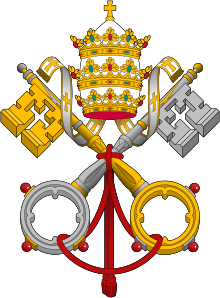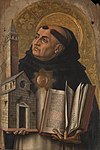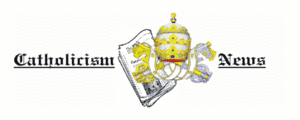Portal:Catholic Church
Introduction The Catholic Church, also known as the Roman Catholic Church, is the largest Christian church, with 1.28 to 1.39 billion baptized Catholics worldwide as of 2024. It is among the world's oldest and largest international institutions and has played a prominent role in the history and development of Western civilization. The church consists of 24 sui iuris churches, including the Latin Church and 23 Eastern Catholic Churches, which comprise almost 3,500 dioceses and eparchies around the world. The pope, who is the bishop of Rome, is the chief pastor of the church. The Diocese of Rome, known as the Holy See, is the central governing authority of the church. The administrative body of the Holy See, the Roman Curia, has its principal offices in Vatican City, which is a small, independent city-state and enclave within the city of Rome, of which the pope is head of state. The core beliefs of Catholicism are found in the Nicene Creed. The Catholic Church teaches that it is the one, holy, catholic and apostolic church founded by Jesus Christ in his Great Commission, that its bishops are the successors of Christ's apostles, and that the pope is the successor to Saint Peter, upon whom primacy was conferred by Jesus Christ. It maintains that it practises the original Christian faith taught by the apostles, preserving the faith infallibly through scripture and sacred tradition as authentically interpreted through the magisterium of the church. The Roman Rite and others of the Latin Church, the Eastern Catholic liturgies, and institutes such as mendicant orders, enclosed monastic orders and third orders reflect a variety of theological and spiritual emphases in the church. Of its seven sacraments, the Eucharist is the principal one, celebrated liturgically in the Mass. The church teaches that through consecration by a priest, the sacrificial bread and wine become the body and blood of Christ. The Virgin Mary is venerated as the Perpetual Virgin, Mother of God, and Queen of Heaven; she is honoured in dogmas and devotions. Catholic social teaching emphasizes voluntary support for the sick, the poor, and the afflicted through the corporal and spiritual works of mercy. The Catholic Church operates tens of thousands of Catholic schools, universities and colleges, hospitals, and orphanages around the world, and is the largest non-government provider of education and health care in the world. Among its other social services are numerous charitable and humanitarian organizations. (Full article...) Selected article
 Ecclesiastical heraldry is the tradition of heraldry developed by Christian clergy. Initially used to mark documents, ecclesiastical heraldry evolved as a system for identifying people and dioceses. It is most formalized within the Catholic Church, where most bishops, including the Pope, have a personal coat of arms. Clergy in Anglican, Lutheran, Eastern Catholic, and Orthodox churches follow similar customs. Institutions such as schools and dioceses bear arms called impersonal or corporate arms.Ecclesiastical heraldry differs notably from other heraldry in the use of special symbols around the shield to indicate rank in a church or denomination. The most prominent of these symbols is the ecclesiastical hat, commonly the Roman galero or Geneva Bonnet. The color and ornamentation of this hat carry a precise meaning. Cardinals are famous for the "red hat", but other offices are assigned a distinctive hat color. The hat is ornamented with tassels in a quantity commensurate with the office.
Selected image
 Credit: Chowells Liverpool Metropolitan Cathedral of Christ the King (usually shortened to Liverpool Metropolitan Cathedral) is a Roman Catholic cathedral in Liverpool, England. It replaced the Pro-Cathedral of St. Nicholas, Copperas Hill. The cathedral is the seat of the Archbishop of Liverpool, the mother church of Liverpool's Catholics, and the metropolitan church of the ecclesiastical Northern Province. Selected biography
 Thomas Aquinas, O.P. (also Saint Thomas Aquinas, Thomas of Aquin, or Aquino; c. 1225 – 7 March 1274) was an Italian Catholic priest in the Order of Preachers (more commonly known as the Dominican Order), a philosopher and theologian in the scholastic tradition, known as Doctor Angelicus, Doctor Universalis and Doctor Communis. He was the foremost classical proponent of natural theology, and the father of the Thomistic school of philosophy and theology. Aquinas is held in the Catholic Church to be the model teacher for those studying for the priesthood (Code of Canon Law, Can. 252, §3). The works for which he is best-known are the Summa Theologica and the Summa Contra Gentiles.
Did you know...

Related portalsFeast Day of November 20
Few historical facts about Edmund are known, as the kingdom of East Anglia was devastated by the Vikings, who destroyed any contemporary evidence of his reign. Coins minted by Edmund indicate that he succeeded Æthelweard of East Anglia, as they shared the same moneyers. He is thought to have been of East Anglian origin, but 12th century writers produced fictitious accounts of his family, succession and his rule as king. Edmund's death was mentioned in the Anglo-Saxon Chronicle, which relates that he was killed in 869 after the Great Heathen Army advanced into East Anglia. Medieval versions of Edmund's life and martyrdom differ as to whether he died in battle fighting the Great Heathen Army, or if he met his death after being captured and then refusing the Viking leaders' demand that he renounce Christ. (Full article...)
Selected quote

News
SubcategoriesTopics
The Holy Bible:
Particular Churches (grouped by liturgical rite):
Things you can do
External resourcesWikiProjectsAssociated WikimediaThe following Wikimedia Foundation sister projects provide more on this subject:
Discover Wikipedia using portals |

































